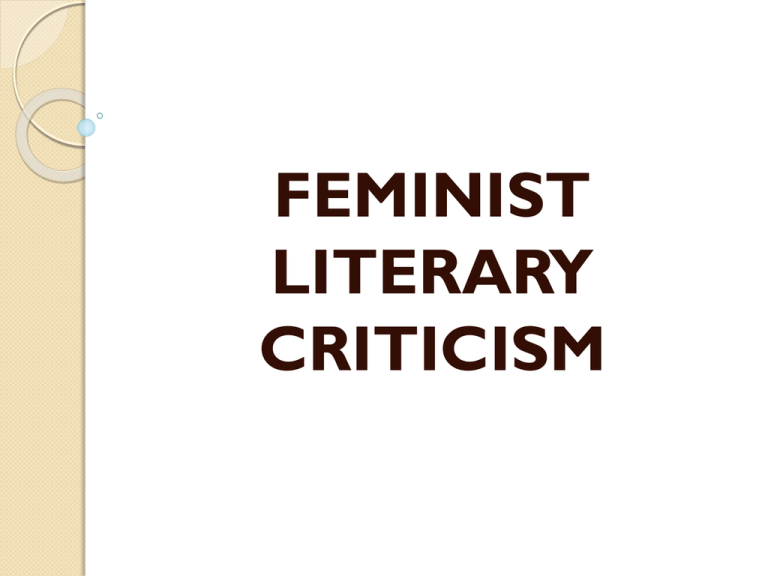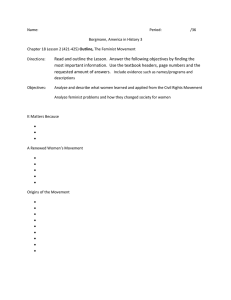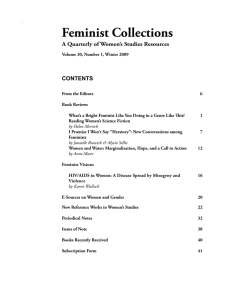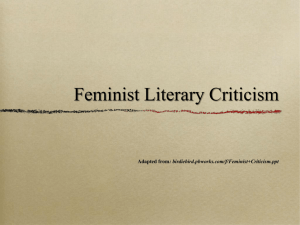
FEMINIST
LITERARY
CRITICISM
What is Feminist Literary Criticism?
Definition…
Feminist criticism
is concerned with
the impact of
gender on
writing and
reading.
Gender versus Biological Sex
Gender refers to the socially constructed
roles, behaviors, activities, and attributes
that a given society considers appropriate
for men and women.
Sex refers to the biological or
physiological characteristics that define
men and women.
Stereotypes
Gender stereotypes
present a conventionally
simplified and
standardized conceptions
or images concerning the
typical social roles of males
and females, both
domestically and socially.
Basically, gender stereotypes
are beliefs held about
characteristics, traits and
activity-domains that are
“deemed” appropriate for
men and women.
Gender Stereotypes
Female Stereotypes are…
Should be mothers, nurturers
Passive
Emotional; over-sensitive
Acquiescent
Others?
Male Stereotypes are…
Father “bread-winner”
Aggressive
Strong
Dominating / leader
Others?
Stereotypes: Consider This…
Patriarchy is…
A social system in
which the father is the
head of the family and
men have authority
over women and
children.
A family, community, or
society based on this
system is governed by
men.
What is Feminist Literary Theory?
They say that the
oppression of
women is an
historical fact and
that literary texts
mirror gender and
social attitudes
about gender.
What is Feminist Literary Theory?
Western
civilization is
patriarchal.
It is male-centered
and controlled, and
is organized to
ensure women
remain subordinate
to men in all
cultural domains.
What is Feminist Literary Theory?
Female characters are marginal and
subordinate, and are represented as
complementary to or in opposition to
masculine desires and enterprises.
Important terms in Feminist Criticism
Male Chauvinist:
A man whose behaviour and attitude towards women indicate a belief that they are innately inferior to
men.
Marginalize:
To regulate to an unimportant or powerless position within a society or group. Historically women
have been marginalized (this is reflected in literature)
Sexist:
Discrimination based on gender, especially discrimination against women (also men!).
Attitudes, conditions, or behaviours that promote stereotyping of social roles based on gender.
Subordinate:
Belonging to a lower or inferior class or rank; secondary
Subject to the authority or control of another.
Objectification:
The presentation of women as “objects” without regard to their personality or dignity.
Literature also examines the sexual objectification of women (and men); women become objects of
men’s sexual pleasure
Characters in Literature
What is the portrayal of women by these examples?
What they portray . . .
Characters in Literature
Characters in Literature
Consider these familiar female characters in
literature:
Desdemona or Portia
Katniss or Hermione
Vidya or Sabine
How are they portrayed in their respective texts?
How to Use Feminist Literary Theory
Questions to Consider when analyzing a text from the feminist approach…
1.
How do the female characters perceive themselves in the text?
2.
How do the male characters perceive the female characters?
3.
Is the portrayal of women (or men) sexist?
4.
Are there any gender stereotypes portrayed in the text and if so, what are
they? Do they give power to a gender, or they suppress a gender?
5.
What is the nature of the relationship between the male and female
characters?
Are there any indications of the author’s attitude toward women?
6.
7.
What were the social and historical conditions for women in this period that
might help us understand their roles and desires in the text?
Working with Feminist Literary Theory
Consider the poem
“My Last Duchess” by
Robert Browning from
a feminist perspective.
How does the text and
meaning derived differ
from that than if it was
analyzed from a
psychological
perspective?






